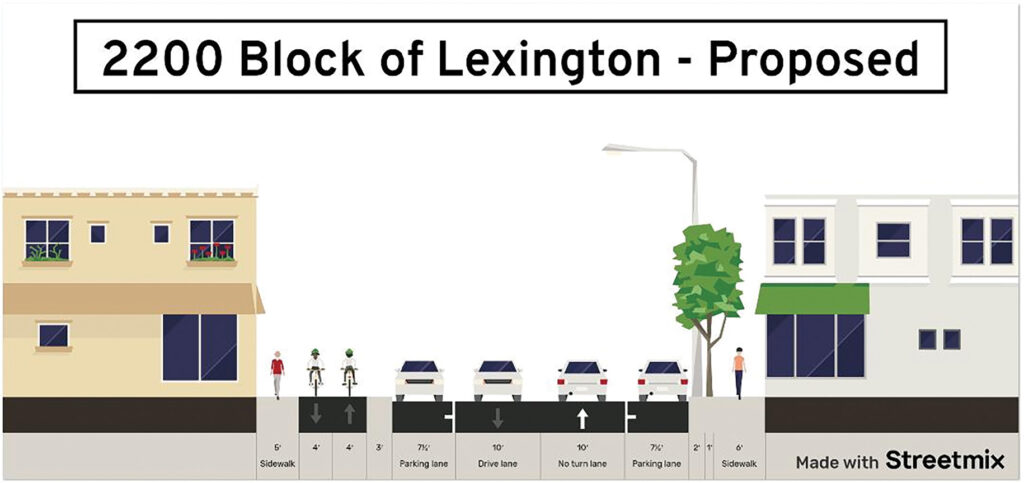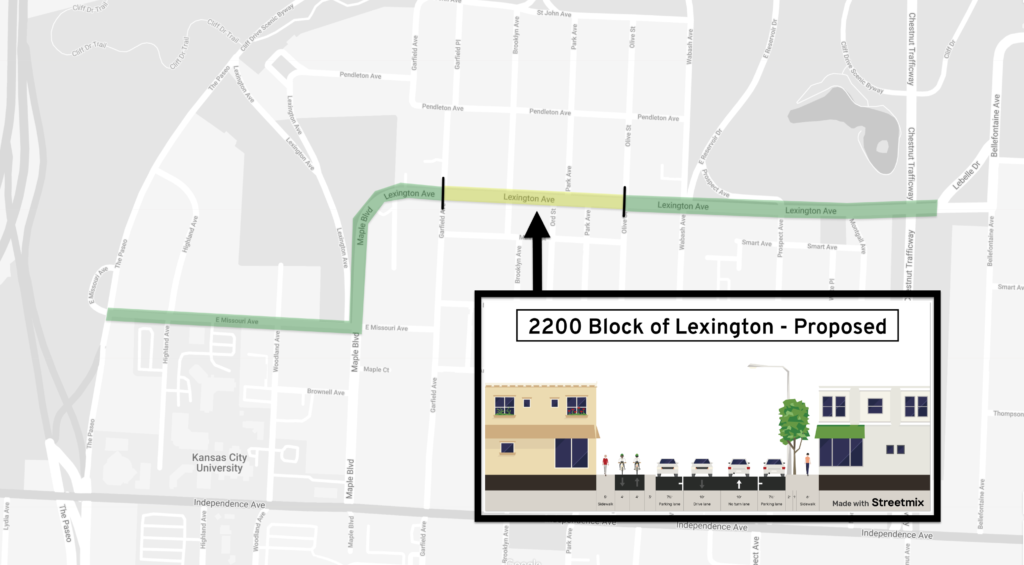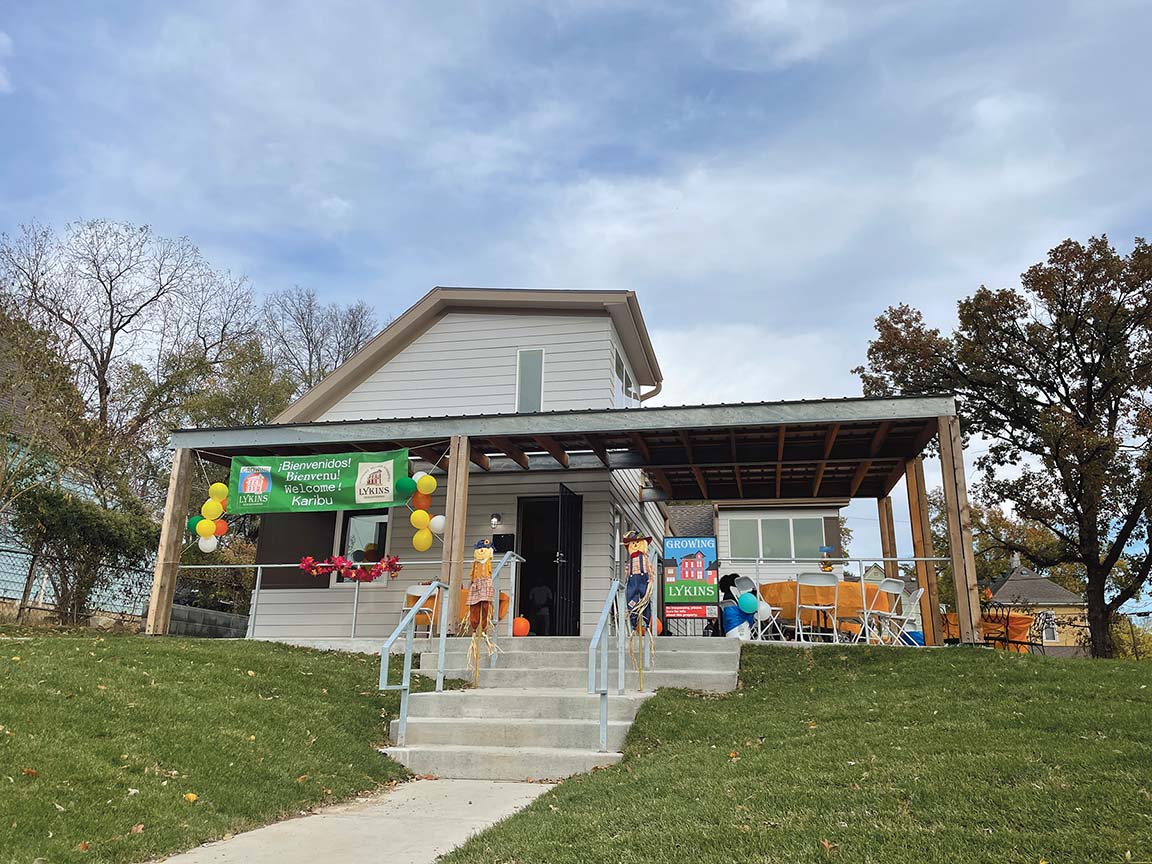
By Abby Hoover
Lexington Avenue in Pendleton Heights may soon be upgraded with a protected bike lane, a plan that has been in the works for more than half a decade. However, residents and stakeholders are asking the City to revisit the years-old plan to accommodate the growing business and multi-family housing community along the corridor.
For years, the community asked for street calming on Lexington Avenue due to consistent speeding.
“They were looking for creative solutions for that problem,” Pendleton Heights Neighborhood Association (PHNA) President Chris Binkley said. “They pursued speed bumps or speed tables, and the City’s refrain on that, traditionally, is they’ll do a traffic study, they come out and they indicate that it’s really – in their view – not enough traffic.”
They then pursued a bike lane to narrow the street and provide safety to alternative transportation. PHNA initially applied for funding for the project through a Mid-America Regional Council (MARC) grant six years ago, Binkley said.
“It’s taken a lot of years for that to actually get engineered, for the City to designate the funds to execute it, and then it’s been delayed mostly because of cost efficiency reasons,” Binkley said.
The project was stalled as resurfacing Lexington Ave. was expected in the future, and they knew their money would go further if they combined the two projects.
In September 2021, the association, whose board has turned over since the project’s initial planning, reached out to the City for an update. After learning that the project could soon be on the horizon, they invited City Project Manager Mario Vasquez to present the plan and share updates with PHNA at their September meeting.
The plan was to install a protected bike lane on the north side of the street from The Paseo Boulevard to Lebelle Drive along East Missouri Avenue, Maple Boulevard and Lexington Avenue. However, it would replace street parking along Lexington Avenue.

While some residents recalled the initial project and were glad it might finally be happening, others who had moved into the neighborhood since then were taken by surprise.
“However, something that has changed from six years ago to today… there’s more of a commercial interest and there’s future development potential,” Binkley said.
Lee Berman, a Pendleton Heights resident and owner of multiple mixed commercial and multi-family residential properties along the route, hadn’t seen the plan before. In 2020, Berman and his business partner completed the renovation of the building on the northeast corner of Lexington and Brooklyn avenues.
PH Coffee opened in Berman’s building in October 2019, just before the COVID-19 pandemic spread. The café has become a hub of community engagement, hosting neighborhood association meetings, yoga classes, discussions on urban planning and pop-up bars.
When Berman heard his first tenant, who had fought to keep its doors open throughout a pandemic, would lose on-street parking, he knew he had to step in. Renovation of the building across the street is nearing completion, with residents already moved in upstairs and tenants moving into the commercial space within the next month.
“The plan is a complete 50% reduction in parking, basically knocking out the entire north side of all of Lexington,” Binkley shared Berman’s perspective from that first meeting. “When he basically heard of a 50% reduction in parking, his antenna went up and it was kind of in a concerned way.”
The current neighborhood association set out to remedy the situation, conducting on-site meetings with Vasquez, and including Berman and longtime Pendleton Heights residentAndrew Ray who helped with the initial plan. Combining the past, present and future of Pendleton Heights was essential to Binkley if the project was going to move forward.
“There’s a key stakeholder aspect of the working group that made this plan that was kind of not as relevant at the time because there weren’t businesses here,” Binkley said. “When you fast forward the tape, it’s kind of like well, this is their front door and this is an emerging economic area of which we hope to be further along where there is a very packed, vibrant commercial buzz for our little like Main Street. While the reality is we’re not there yet, we’re trying to get there.”
Street calming remains one of the top three priorities of the neighborhood, according to last year’s community survey, but another is economically revitalizing the Lexington corridor.
After months of reworking the plan, they came to an agreement. What they came up with was a community-designed compromise. They would request a revision to the original plan that would allow for on-street parking in both directions on Lexington between Olive Street and Garfield Avenue with a protected bike lane. To achieve this, there would have to be alterations to the curbs in this section – which will cost more. The amended plan would maintain the overall previous design concept of continuous protected bike lanes on Lexington Avenue.
The original plan was already engineered, at no small cost, funded and was going to be bid this fall. But now that the neighborhood is requesting revisions, that timeline is on hold.
“I think it’s great that the neighborhood association engaged with us and said, ‘Wait a minute, this is not the right plan for 2021, it’s the right plan for 2014 when there was an abandoned strip, inactive people, no car traffic, and a stoplight there,’” Berman said, adding that surface parking lots are the death of cities. “If you look at spatial use in cities, street parking is the most efficient way to bring in cars – which in my opinion is an unfortunate reality of cities, just as an urbanist – but the most efficient use of space is to do it in the streets.”
Binkley penned a letter of support for the amended plan on behalf of the board for a Lexington Avenue Bike Plan to Kansas City Mayor Quinton Lucas, City Manager Brian Platt, and Council members Melissa Robinson, Brandon Ellington and Eric Bunch.
In October, Robinson introduced Ordinance 210966, which would require community input on bike lanes in the Third District, which includes Pendleton Heights. PHNA, the Lexington business community and key stakeholders requested the amended project be added to the high-priority list of projects associated with the ordinance, should it be passed. The ordinance should be heard by Council in December.
The new plan has earned broad support from the Pendleton Heights neighborhood, and Binkley believes it will be a strong catalyst for continued growth along the corridor, adding that all involved believe this compromise is practical and achievable given proper time to update the four-block area of the plan.
The PHNA supports bike lanes and this amended project because it will create long-awaited traffic calming on Lexington Avenue, improve the safety of all transportation options, connect the community to surrounding planned facilities, support continued economic revitalization, and keep federal funding allocated for the community, Binkley wrote.
“Mario [Vasquez] has been extremely helpful… his only concern was how do we get that incremental extra money to accommodate our request, and he’s not said it’s an impossibility,” Binkley said. “I think it’s got momentum.”
The Lexington Avenue businesses support this amended plan because it adds biking facilities, an amenity they want, while still preserving critical on-street parking on the north side of the street. Binkley estimated 60% of PH Coffee’s revenue comes from outside of Pendleton Heights.
“I just would love to see it implemented because it will embolden people, once it kind of connects more to the downtown area, we believe that we can be one of the prime pocket communities for commuting to downtown but living in a family friendly, safe, kids play on the streets, connected community that shows the model of how the City can work with the businesses, work with the families, the bicyclists and the residents,” Binkley said.
Now, they would like the City’s help in backing the project by supporting the community-led amended project plan and in finding additional funding to adjust curbs for four blocks to enable the plan to be implemented and be an asset for decades to come.
“If you fast forward five years, we feel like this is a key design choice that will have a lot of downstream effects, and we need every benefit on our side as we try to attract restaurants and try to attract other little things the neighborhoods have asked for,” Binkley said. “We see it as an opportunity for more strollers, more scooters, more multimodal access, which as the City implements redevelopment of Choteau Courts and the new intersection and all of that, it kind of starts to connect. We’re going to have this great new facility that comes in.”
Kansas City’s Public Works department has a Lexington/Gladstone Bikeway plan, running east to west in the City’s Historic Northeast neighborhoods, extends from Indian Mound Park west to Independence Avenue and Maple Boulevard. The current status of the project hasn’t been updated since September 2017 when design meetings commenced.
The type of bike facilities along each corridor are still being decided upon as budget and neighborhood feedback are considered, and more meetings for the broader neighborhoods will be announced soon, the planning website reads.
“I hope the City sees this is not creating another plan, this is taking a good plan – and right before it was about to be executed, before we were about to make a mistake for the current community and the community that’s going forward – to just make a minor amendment, which might cause some reengineering,” Binkley said. “But the community has done listening sessions, it’s been a long time waiting, kind of overdue. This amendment is really just to honor all this work that’s been done, let’s do it right before we start pouring concrete that’ll be there for 25 years. Let’s do it in a way that helps us flourish for the future and not just get bike facilities checked off the list.”


















